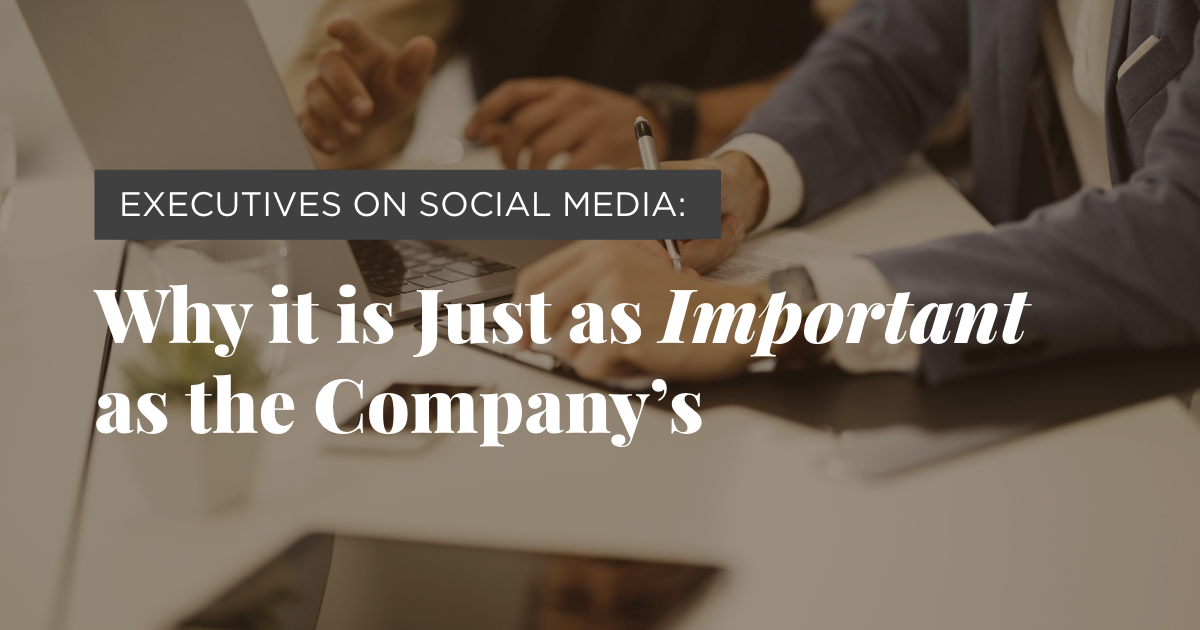Maintaining an executive’s social media presence is no longer just a nice-to-have for organizations and their leaders. It’s becoming an essential part of every company’s business model. Still, far too many executives are avoiding social media altogether — and it could be costing them in more ways than expected. Keep reading to learn more about the benefits of having your executives on social media, as well as how it should be positioned differently from the brand’s social media.
Why should an executive post on social media?
A personal brand is one of the most valuable assets a senior executive can have in today’s business environment. Social media enables leaders to take charge of their personal brand and share it with their co-workers, clients, industry peers, and even new audiences.
Executives are already well-positioned to be thought leaders within their respective industries, as the achievement of their position is evidence itself of their expertise. By growing, establishing, and maintaining their voice, business leaders have the potential to shape public opinion through social media. Executives have the opportunity to engage in public conversations and share their expertise, giving them a chance to demonstrate what they stand for, what they value, and what they are working to achieve.
Not only does a personal brand tell people who an executive is and what they value, but it also provides a glimpse of what it’s like to work for them. A social media presence can become a powerful tool for attracting and engaging in conversations with potential candidates and customers.
Executives can better understand what motivates these candidates by skimming through their social media before bringing them into the interviewing process. In turn, candidates are able to get a better understanding of the company. While the branded accounts allow a candidate to familiarize themselves with the company’s products and services, an executive’s account can provide additional clarity about the company’s culture— enabling them to better envision how they may or may not fit in the role.
Having your executives on social media also paints a more complete picture of your company for potential clients and customers. Instead of being limited to familiarizing themselves with the company through branded social media accounts, an executive’s posts allow them to learn more about the motivations, experiences, and values of the people behind the brand, speeding up the process of building foundational relationships.
How should an executive’s social media posts differ from the company’s posts?
Many brands use social platforms as a way to connect with customers, share information about the company, and promote the company’s products and services. That said, the purpose of a company’s social media presence often differs from the purpose of an executive’s social media presence, and this difference can range in style depending on the executive’s goals as well as their industry.
What is important to understand is that these two presences do not negate each other; rather, they work together by serving their own unique, complementary functions.
Just like the accounts of an executive, a company needs its own identity and voice. This is important as it will guide the way that you communicate with your audience. The company’s voice depends on both branding strategy and what makes sense in the context of the company’s industry. No matter what the company’s voice is, it should be relatively consistent in order to avoid confusing potential and existing customers.
The company’s identity and voice do not need to perfectly align with that of the company’s executives, but they may overlap. While posting as an industry and thought leader, posts may include subjects that pertain specifically to operating in the executive’s industry, demonstrate a high level of expertise in a subject, or even include personal updates. In fact, sharing personal updates that are authentic to the executive poses an opportunity to build credibility and trust among audiences and those in their respective professional communities. However, this style of content might not make its way to the brand’s social media accounts, as the focus is typically instead on creating content that resonates with customers and maintaining a consistent, branded voice.
The executive’s social media accounts provide an additional channel to share updates without disrupting the voice of company accounts. Not only does this provide the opportunity for executives to begin building their personal brands, but it also allows for achievements and updates to be shared with the right audiences.
What do the differences between an executive’s social media post and a brand’s social media post look like?
Tinder and Renate Nyborg: Same topic, two strategies.
How are the top executives utilizing their social channels? Renate Nyborg, CEO of Tinder, shared a post on her LinkedIn about a new feature that Tinder’s official Twitter account also tweeted about. While the subject matter of the tweet is the same, the differences between them demonstrate an executive’s opportunity to share insights into the company’s culture and achievements without disrupting the promotional messaging sent by the branded account.
In Nyborg’s post, the focus of the post is the effectiveness of the new feature and the team that developed it. By including in her post that the new feature enables users to find 40% more matches, she has established and shared with her network the company’s achievement of launching a highly successful feature. Simultaneously, she is able to build her personal brand by sharing her professional experience in working on the update.
By focusing on the specific results of a new feature, the company’s goals and its ability to meet those goals are emphasized. As this new feature purports to bring more matches to users, it is apparent that Tinder cares about developing and investing in new and creative ways for its users to get added value from the app. Quantifying how that goal is met spotlights the company’s ability to succeed in these endeavours. Nyborg also quotes the Vice President of Core Product in her post, emphasizing a team-oriented, collaborative workplace culture.
Wanna break the ice? 🧊👀 Try out Fast Chat: Blind Date in Tinder Explore. Answer questions with a mystery member and get to know them before the timer runs out, then match with them to reveal their profile 🔥 pic.twitter.com/mcSg3PscSM
— Tinder (@Tinder) February 11, 2022
As seen above, the tweet from the company’s official account emphasizes different aspects of the feature. The tweet details how the feature works in a fun and lighthearted fashion, sticking to the established voice of the brand. Users do not necessarily need to know the success rate of the feature and what the people who developed it think about it. Rather, they need to be introduced to the feature in a way that catches their attention and makes them excited to try it out.
Posting on both Nyborg’s personal channel as well as the company’s account allows for one update to serve multiple, distinct purposes, each with its own equally important intentions.
How can executives share personal posts on social media to build authenticity?
Adam Aron, CEO of AMC Theatres, and Authentic Sharing on Twitter
A great example of an executive using social media to build visibility and authenticity in a way that users want to engage with is Adam Aron’s presence on Twitter. At the beginning of 2021, internet users made AMC go “viral” on social media, spurring an influx of users to follow his account. Since this development, Aron has leaned into his presence on the internet rather than shying away from the attention, which has made for an interesting example of how an executive can harness the power of their personal social media presence in an authentic yet professional way.
I’ve been at several great companies over my 45 year career, but have told you before it is the honor and privilege of a lifetime to run YOUR company, AMC. So too, it has been unique to engage with you on Twitter. This week, a milestone — 250,000 Twitter followers. Thank you all! pic.twitter.com/G3QEJvksBC
— Adam Aron (@CEOAdam) April 7, 2022
Aron has built his Twitter account up to over 250,000 followers and continually sees high engagement on each post no matter the subject. How has he been able to maintain this following? By sharing his day-to-day experiences, engaging with the community he has built, and speaking authentically about his role as CEO. Check out a few examples of his tweets below.
Greetings to the Twitter-verse. Here I am at the Dolby Theater in Los Angeles for the 94th Oscars. pic.twitter.com/LFvHP7MvqS
— Adam Aron (@CEOAdam) March 27, 2022
In this tweet, Aron shared that he was at the Oscars with a quick selfie and an image of the venue. As can be seen here, it does not take much to craft an authentic post that users want to engage with! Just by sharing his experience, users took to the replies to comment on his update, posting both lighthearted memes and positive words of encouragement.
Many of you know I love “my” Philadelphia 76ers. Tonight, in LA, I watched them trounce the Clippers. Here at the post-game press conference are Joel Embiid and James Harden — two of the greatest players in the game, and two future Hall-of-Famers! pic.twitter.com/ZMjiji5Pwq
— Adam Aron (@CEOAdam) March 26, 2022
Here we see Aron at a post-game press conference for the Philadelphia 76ers. While this situation does not relate specifically to his position as CEO, it provides an authentic insight into his own interests, allowing him to connect on a personal level with his followers.
AMC’s Q4 of 2021: 60 million guests in our theatres, 8 million a year ago. Revenues per patron 25% more than pre-pandemic 2019 Q4. $160 million EBITDA. $220 million operating cash generated. A record $1.8 billion of year-end liquidity. So encouraging, but more needs to be done. pic.twitter.com/6nPKtlpl2n
— Adam Aron (@CEOAdam) March 2, 2022
Not only does he post personal updates, but he also provides insight into his life as the CEO of AMC Theatres, as seen in this post. By sharing important information about AMC, and doing so honestly, he brings attention to his work while maintaining the authenticity his followers have come to know and respect.
To sum it all up: Why is it important for an executive to maintain a social media presence if there is already an established social media for the brand? Executives can represent themselves as well as the culture and achievements of a company, allowing for branded accounts to focus on engaging with customers in a way that resonates with them. Each channel serves a purpose, and neither should be overlooked!
Are you looking to build an effective social media presence as an executive? We can help! At Influential Executive, we specialize in creating high-level strategies that can elevate your brand and your business across all major social channels.
href="#" data-color-override="false" data-hover-color-override="false" data-hover-text-color-override="#fff">Click here to see how we increased brand awareness at a cyber security firm.

